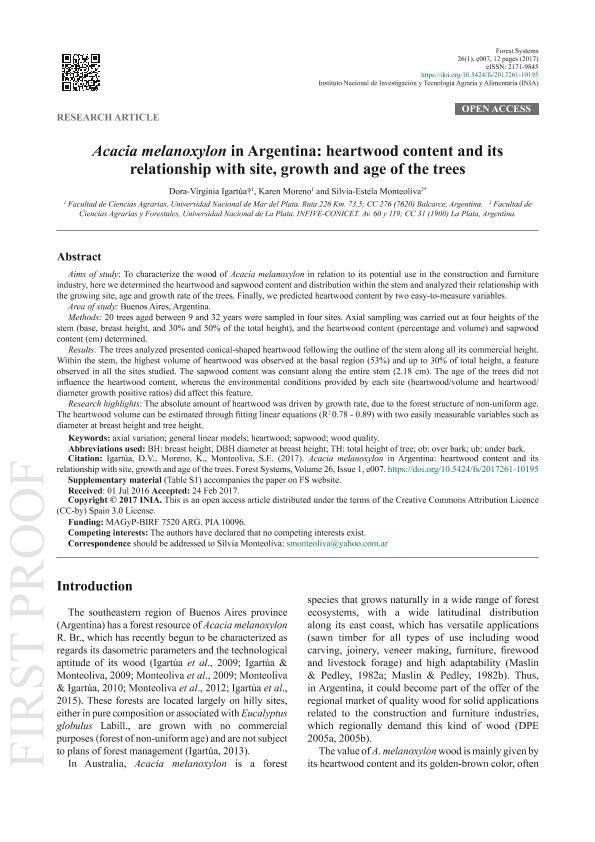Mostrar el registro sencillo del ítem
dc.contributor.author
Igartúa, Dora Virginia

dc.contributor.author
Moreno, Karen Gabriela

dc.contributor.author
Monteoliva, Silvia Estela

dc.date.available
2018-12-17T19:43:13Z
dc.date.issued
2017-01
dc.identifier.citation
Igartúa, Dora Virginia; Moreno, Karen Gabriela; Monteoliva, Silvia Estela; Acacia melanoxylon in Argentina: Heartwood content and its relationship with site, growth and age of the trees; Ministerio de Agricultura Pesca y Alimentacion; Forest Systems; 26; 1; 1-2017; 1-12
dc.identifier.issn
2171-5068
dc.identifier.uri
http://hdl.handle.net/11336/66603
dc.description.abstract
Aims of study: To characterize the wood of Acacia melanoxylon in relation to its potential use in the construction and furniture industry, here we determined the heartwood and sapwood content and distribution within the stem and analyzed their relationship with the growing site, age and growth rate of the trees. Finally, we predicted heartwood content by two easy-to-measure variables. Area of study: Buenos Aires, Argentina. Methods: 20 trees aged between 9 and 32 years were sampled in four sites. Axial sampling was carried out at four heights of the stem (base, breast height, and 30% and 50% of the total height), and the heartwood content (percentage and volume) and sapwood content (cm) determined. Results: The trees analyzed presented conical-shaped heartwood following the outline of the stem along all its commercial height. Within the stem, the highest volume of heartwood was observed at the basal region (53%) and up to 30% of total height, a feature observed in all the sites studied. The sapwood content was constant along the entire stem (2.18 cm). The age of the trees did not influence the heartwood content, whereas the environmental conditions provided by each site (heartwood/volume and heartwood/diameter growth positive ratios) did affect this feature. Research highlights: The absolute amount of heartwood was driven by growth rate, due to the forest structure of non-uniform age. The heartwood volume can be estimated through fitting linear equations (R2 0.78 - 0.89) with two easily measurable variables such as diameter at breast height and tree height.
dc.format
application/pdf
dc.language.iso
eng
dc.publisher
Ministerio de Agricultura Pesca y Alimentacion
dc.rights
info:eu-repo/semantics/openAccess
dc.rights.uri
https://creativecommons.org/licenses/by-nc-sa/2.5/ar/
dc.subject
Axial Variation
dc.subject
General Linear Models
dc.subject
Heartwood
dc.subject
Sapwood
dc.subject
Wood Quality
dc.subject.classification
Agricultura

dc.subject.classification
Agricultura, Silvicultura y Pesca

dc.subject.classification
CIENCIAS AGRÍCOLAS

dc.title
Acacia melanoxylon in Argentina: Heartwood content and its relationship with site, growth and age of the trees
dc.type
info:eu-repo/semantics/article
dc.type
info:ar-repo/semantics/artículo
dc.type
info:eu-repo/semantics/publishedVersion
dc.date.updated
2018-10-22T22:30:20Z
dc.journal.volume
26
dc.journal.number
1
dc.journal.pagination
1-12
dc.journal.pais
España

dc.journal.ciudad
Madrid
dc.description.fil
Fil: Igartúa, Dora Virginia. Universidad Nacional de Mar del Plata. Facultad de Ciencias Agrarias; Argentina
dc.description.fil
Fil: Moreno, Karen Gabriela. Universidad Nacional de Mar del Plata. Facultad de Ciencias Agrarias; Argentina
dc.description.fil
Fil: Monteoliva, Silvia Estela. Consejo Nacional de Investigaciones Científicas y Técnicas. Centro Científico Tecnológico Conicet - La Plata. Instituto de Fisiología Vegetal. Universidad Nacional de La Plata. Facultad de Ciencias Naturales y Museo. Instituto de Fisiología Vegetal; Argentina
dc.journal.title
Forest Systems
dc.relation.alternativeid
info:eu-repo/semantics/altIdentifier/doi/https://dx.doi.org/10.5424/fs/2017261-10195
dc.relation.alternativeid
info:eu-repo/semantics/altIdentifier/url/http://revistas.inia.es/index.php/fs/article/view/10195
Archivos asociados
